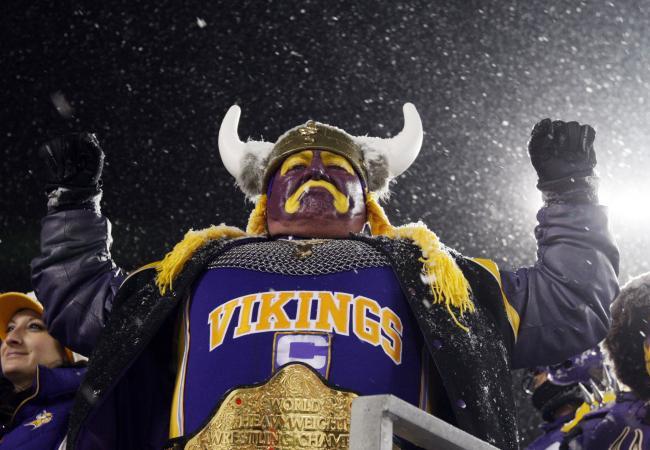Nearly $500 million in taxpayer subsidies will go to a new stadium for the Minnesota Vikings of the National Football League.
Gov. Mark Dayton (DFL) signed the bill authorizing the taxpayer giveaway in May. Many Vikings fans greeted the bill signing with jubilation. Taxpayer advocates and economists who study the impact of sports stadiums warned the promised benefits are unlikely to materialize.
The team’s principal owner is billionaire real estate magnate Zygmunt Wilf.
Several days after the governor’s signing ceremony, the Minneapolis City Council passed a measure ratifying the city’s share of the stadium subsidies, which consists of $150 million in construction costs. In addition the city will provide another $159 million in operating expenses over the life of the lease.
The new stadium is expected to keep the Vikings in Minneapolis for another 30 years.
Number of Jobs Disputed
Dayton defended the taxpayer subsidies during an appearance on Minnesota Public Television, arguing they will create jobs.
“I believe it’s the best deal available under the circumstances.… The bottom line was, do we want to create several thousand jobs by building this new facility?”
State Sen. John Marty (DFL-Roseville) gave an opposing view. In an end-of-session report to his constituents he stated the Vikings’ lobbying push was “successful in convincing politicians that it was a good way to create construction jobs, twisting the numbers in a manner that convinced some public officials that it would create far more than the equivalent of 700 full-time jobs over the 3 years of construction.”
He added, “Minnesota has an urgent need to create more building trades jobs, [and] we would create far more jobs using public dollars to fix our public infrastructure,” instead of providing subsidies to a stadium for a privately owned sports team.
Subsidy Gravy Train
The Vikings had been seeking a new stadium for more than a decade but were repeatedly stymied by opposition to pouring yet more taxpayer dollars into sports arenas. In recent years the Minnesota Twins (Target Field, $392 million subsidy), Minnesota Wild (Xcel Energy Center, $130 million in ‘loans’ from state and city, much of which has been ‘forgiven’), and Minnesota Timberwolves (Target Center, $80 million from Minneapolis to purchase arena) have all been on the receiving end of significant taxpayer subsidies.
Legislation to provide taxpayer funds for a Vikings stadium had appeared doomed for 2012. But Governor Dayton, frequently referred to as the “biggest cheerleader” for a new stadium, successfully worked with key allies to put together a deal.
Backroom Dealing Saved Subsidies
Some observers criticize the deal not just as a handout to billionaire owners (brothers and team co-owners Zygi and Mark Wilf reportedly have at least $2 billion of net worth) but as an example of corrupt backroom politics that kept the public in the dark throughout the process.
In a blog post titled “State of Corruption: How the Vikings Stadium Deal Went Down and Took Honest & Open Government With It,” former Minneapolis-Star-Tribune reporter Mark Coleman reported on how the governor and legislative leaders allegedly skirted important open-meetings and transparency laws to get the deal done.
In the conference room where the deal was being hammered out, Coleman reports, “two or three members of the Legislative Conference Committee were meeting—but never more than that number. The six-member conference committee … only needed four legislators for a quorum, and a quorum would trigger the state’s Open Meeting law, requiring that the doors to the deliberations be opened to the press and public.”
As a result, “The public had no input into the process,” Coleman told Budget & Tax News.
General Revenue Committed
Minnesota State Rep. Mary Kiffmeyer (R-Big Lake) expressed concern the deal commits revenue from the state’s general fund instead of relying on user fees. Although some revenue is scheduled to come from gambling, if that projected revenue doesn’t materialize the state’s general fund revenues will be used for construction and bond payments.
“The taxpayer lost out on this and is at great risk,” Kiffmeyer said. “Making other people pay for what a few want—especially sports, which is not an essential function of government—is bad public policy.”
She suggested a more appropriate way to fund the stadium would have been through user fees such as surcharges on tickets and luxury boxes, or the proceeds from special license plates.
“It’s a choice that way,” Kiffmeyer said. “That way the people who use it pay for it.”
Wilfs to Pay Little or Nothing
While politicians and media reporting the deal typically state the Vikings will be putting in $477 million toward construction costs of the new stadium, this likely overstates the figure significantly. An estimated $210 million of the Wilf brothers’ portion of the costs is to come from the sale of stadium naming rights, even though the state will own the stadium, and the NFL is kicking in $200 million in loans to be paid back through funding that would otherwise be shared with other teams.
“The Wilfs will never pay a nickel,” Coleman said. “We got snookered, and this deal will go down as a bad deal for taxpayers.”





